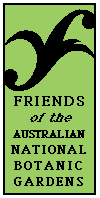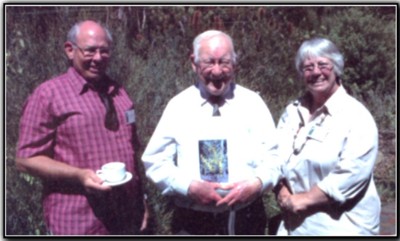Once again the
ANBG Friends have enjoyed a successful year, thanks to the untiring
enthusiasm of our volunteers. Our membership has increased, the many
activities we have organised have attracted more people and we have
been able to maintain our support for the Gardens at a high level.
At 1 February 2006
we had 1451 members, compared with 1309 at the same time last year and
1291 the year before. IT seems likely that the main reasons for this
increase are the higher profile that events in the Gardens have attracted
in the media and the greater number and diversity of high-quality activities
we have been able to offer our members. Considerable effort can be required
to organise the wide range of services and activities offered by the
Friends and much of the work involved falls on the shoulders of a core
of willing stalwarts who share a common love for the Gardens. These
are the people who have given the Friends the strength that underlies
our success. Late last year a ceremony was held in the Gardens to recognise
those of our volunteers with ten or more years of service. Greg Hunt,
the Parliamentary Secretary for the Environment, officiated at the ceremony
and awarded certificates. He also presented to Bernard Fennessy, one
of our most active and longest serving volunteers, a special folder
containing a compilation of Bernard's "What's in a Name" articles
which have appeared in Friends Newsletters for many years.
However, while
it is good to be able to properly acknowledge the achievements of our
long-standing volunteers, we still need more of our members to become
actively involved in the running of our organisation. Not only would
we benefit from the new ideas and enthusiasm they can be expected to
contribute but we would also be able to spread the load more equitably
and ease the burdens carried by some of our well-known 'willing horses'.
A constant infusion of healthy new blood will ensure that we remain
a strong and dynamic organisation which can be relied upon to make a
worthwhile contribution, not only to the Gardens, but also to the wider
community in which we live.
The 24 new volunteer
guides who received 'graduation' certificates at the end of their training
course late last year were a very welcome addition to our ranks. They
were very much needed to maintain our capacity to run our regular scheduled
program of guided walks (two every day of the year except Christmas
Day and three from January to March), as well as a significant number
of special walks. It seems that some of these new guides have already
succumbed to the charms of the attractive Gardens environment to such
an extent that they have already volunteered to help with other Friends'
activities.
We have maintained
our commitment to provide funds each year to the Gardens for agreed
projects. During the past year an amount was allocated to the restoration
(including the incorporation of a new Flowform cascade) of the creek
by the side of the Visitor Centre. In view of the healthy financial
situation of the Friends we have agreed to substantially increase our
contribution to the Gardens beyond the current annual funding for the
Friends' projects. Appropriate mechanisms to implement this are currently
being developed, taking into account that, at present, there appear
to be fewer opportunities for relatively small, worthwhile projects.
Rather than simply lifting the annual ceiling, it may be preferable
to incorporate a provision whereby we can save for a larger project
over a three year period.
The ANBG Friends
Public Fund (to receive tax-deductible donations in order to provide
substantial support for projects that will enhance the Gardens) is well
and truly established and its Committee of Management has met regularly.
During the past year, Professor Frank Fenner resigned from the Committee
and was replaced by Dr Robert Boden, a former Director of the Gardens.
Progress on the design and construction of the first project to be financed
by the Fund, a public shelter adjacent to the Rock Garden Lawn, has
been frustratingly slow for a number of reasons, including the need
to refine the design in order to met the project's budget. At this stage,
we expect that construction of the shelter will be completed within
the first half of this year. The official opening of the shelter will
provide a good opportunity to further promote the Fund and attract additional
donations. The publicity material on the Fund, displayed on the cover
sheet for the Friends Newsletter, appears to have had some success in
attracting donations, but we still need to explore new sources, including
those in the corporate sector, if we are to achieve significant growth
in the Fund.
Once again, projects
attracting financial support from the Friends have included the annual
Photographic Competition for High Schools and Secondary Colleges (last
year there were 197 entries from 9 schools and colleges) and the provision
of book vouchers for Botanical Interns.
Our hard-working
and creative activities committee arranged a full and diverse range
of high quality activities for Friends during the past year, most of
which were well attended. Apart from an impressive program of talks
by expert speakers, events on the program have included workshops, demonstrations,
'behind the scenes' tours, the very popular series of 'Breakfast with
the Birds', the weekend excursion to Young and Cootamundra, and the
Friends Twilight Dinner. The development and management of many of these
events involves considerable effort and organisational ability and we
are fortunate in having a core of very capable people willing to contribute
their time and skills. However, we cannot reasonably expect the same
people to be available whenever we need them; they have other commitments
too. Last year we simply did not have the people available to mount
'Grazing in the Gardens', a popular (but very resource-consuming) event
in previous years. In an attempt to spread the workload involved in
organising such events we have decided to establish a Social Events
Committee which will be responsible for the development, management
and co-ordination of Friends' major social events throughout the year.
The publicity was
excellent this year and attracted large crowds. Indeed, so popular have
the Sunday concerts become that on some occasions, there was barely
enough space for them on the Cafe Lawns and, in future, we may have
to consider moving them to the more spacious Eucalypt Lawn. Only one
concert had to be cancelled, owing to a sever weather warning.
The Growing Friends
gained several new members and held a successful plant sale last April.
Unfortunately, potting mix problems once again prevented sufficient
plants being available to make a Spring Sale worthwhile. Happily, it
appears that these problems have been overcome and there will be a sale
on 1 April 2006.
The Friends Botanic
Art Group is now well established and up to a dozen members meet each
month to paint and share their skills with each other. Some of the work
produced by members of the group will be on display at the next Growing
Friends plant sale.
Many Friends have
expressed their appreciation for the refurbishment of the Friends Lounge
carried out during the year. The new furniture and fresher appearance
of the Lounge have made it a much more attractive place in which to
meet other Friends and to relax and browse the material on display.
Despite the considerable
extra pressures arising from major staffing changes within the Gardens,
particularly in the Public Programs area, Gardens' staff, both new and
old, have continued to be helpful and co-operative whenever Friends
have sought their assistance. Invariably, they find time to assist the
Friends with their expertise when it is needed and their constructive
support is paramount in maintaining the strong and mutually supportive
environment that benefits us all.
I have enjoyed
working with members of the Friends Council during the past year. All
members have worked well together as a team and have made significant
contributions to the management of Friends' business. When individual
members have been unavailable at times during the year, others have
willingly and spontaneously agreed to 'back-fill' their positions. It
is a pleasure to work in such a cooperative environment with a team
of competent and well-motivated people and it augers well for the future
success of the Friends.


